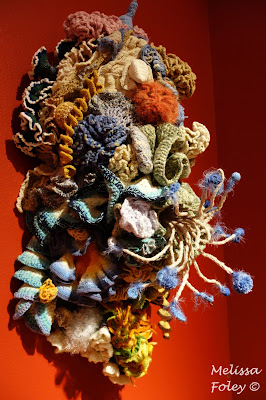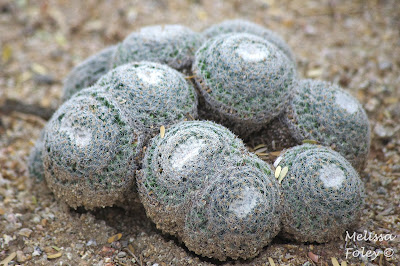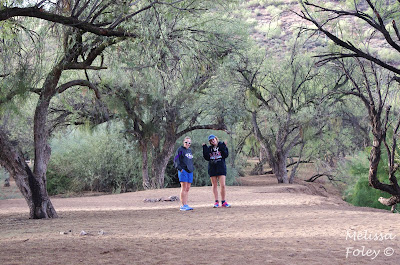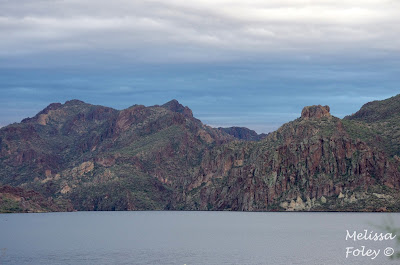I flew to Phoenix in November to meet up with sister Sarah and niece Madeline. Sarah was competing in her fifth ironman triathlon, and Madeline and I are her official cheering team. We've been practicing for a long time...our first cheering gig was in 2004! The ironman is 140 miles of craziness - 2 miles swimming, 112 biking, and 26 running - and it takes a good chunk of the day for most people to complete the whole thing. We planned on Sarah taking around 12 to 13 hours to complete the race so we needed to have some activities while she wasn't near a place we could cheer her on.
swimming start at 0:dark:30
Sarah getting in the water (second pink cap from the top)
a gazillion bikes in the transition area
about 10 miles into the run
200 feet from the finish (note the bloody knee -
she crashed her bike on some loose gravel
but finished the entire 26 mile run despite the pain)
finish line!
and then straight to the medical tent for some first aid!
While the race was underway, Maddy and I had a few ideas for things we could do to pass the time. We both have a bit of a photography "problem," so we were great company for each other. She was enrolled in a photography class at her school and needed to build her portfolio for the week, so we had a legitimate excuse for seeking good photo opportunities around Phoenix. Our first stop was the botanic garden.
If you've been reading this blog for any amount of time, you know that I visit botanic gardens in most cities I travel to if possible, and that I am a flora junky, in general. Turns out that I might have an obsession with cactuses and succulents. I've known this for a while, but this was the first desert botanic garden I have been to in a long time and I was completely nerding out. But just look at all of these different varieties...
team photography (if you look closely there are
three cameras between us and another
one taking the photo. Problem? Nah!)
saguaro cactus
saguaro growing a new top
crested saguaro cactus
(scientists think the crested morphology
is caused by a genetic mutation)
crested whortleberry cactus
star cactus
old-man cactus
prickly pear cactus with fruit
prickly pear cactus
paper spine cactus
rebutia cactus
barrel cactus and a sun dial
ocotillo version #1
ocotillo version #2
barrel cactus and mockingbird
organ pipe
starfish cactus
crested cactus
Cactuses evolved in dry, often times but not necessarily hot, climates. They have specific adaptations that allow them to persist for months at a time with little water. The spines are akin to leaves that provide protection from grazers and lose much less water than a standard leaf, and their stem is modified to be able to store a lot of water. But as it turns out, cactuses, which are only native to North and South America, are not the only plants that developed these adaptations. Succulents are found the world over and independently evolved many of the same characteristics, a phenomenon called convergent evolution. Essentially that means those adaptations are so good in dry, harsh conditions that species completely physically separated from one another developed those adaptations independently, and individuals with those characteristics survived and reproduced better than plants without those characteristics generation after generation.

looks like a cactus...but it is a succulent (Euphorbia)!
Our second stop on race day was lunch with my great aunt Nola. She spends much of the year in Sun City and invited us over for lunch. We ate lunch at a restaurant that overlooks a couple of exhibits at a private zoo. We were seated in front of the giant aquarium inside because it was raining, but we had to go visit the flamingoes outside before we left. We saw a cool sight at the flamingo exhibit...a juvenile getting fed by an adult. It appeared to be liquid rather than whole critters, but we were not close enough to tell for sure. The feeding process took over ten minutes!
adult flamingo feeding a juvenile
The day after the triathlon, Sarah wanted to do some hiking to keep her muscles from seizing and Madeline wanted to find some wild horses. We got up early and headed east of Phoenix to the Tonto National Forest. We didn't find any horses, but we did get to see some lovely scenery.
Sarah and Madeline among the mesquite trees
Salt River reflections
Least sandpiper looking for breakfast
Saguaro Lake
Our next hike was going to be up Camelback Mountain, but just as we arrived at the trailhead it started lightning and then down pouring. Mountain tops and lightning do not go well together, so we opted for an early lunch that also doubled as a chance to dry out a bit. By the time lunch was over, the sun was trying to come back out so we hiked up and around Hole in the Rock. Sarah and Maddy were able to go back to Camelback after I left, so all the hikes got checked off the list.
Hole in the Rock
Soaking up the sunshine
Madeline and I decided that Sarah needs to do one more ironman so we can cheer her on in style (we forgot our cow bell). I'm not sure if she is going to go along with that, but if she does we will be there!



























































